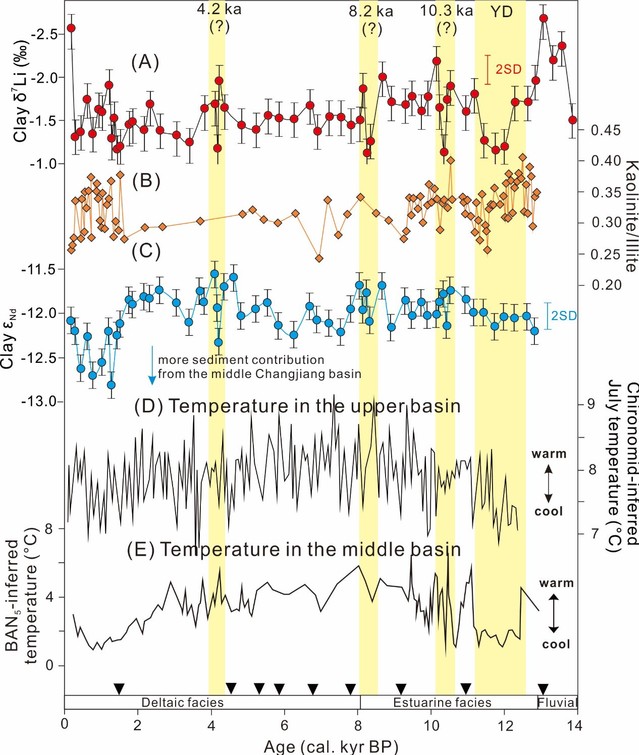Chengfan Yangab, Nathalie Vigierb, Shouye Yanga, Marie Revelc, Lei Biad
a State Key Laboratory of Marine Geology, Tongji University, 1239 Siping Road, Shanghai 200092, China
b Oceanography Laboratory of Villefranche (LOV), IMEV, CNRS, Sorbonne University, 06230 Villefranche-sur-Mer, France
c Université Côte d'Azur, CNRS, Observatoire de la Côte d'Azur, IRD, Géoazur, 250 rue Albert Einstein, 06905 Sophia Antipolis, France
d Polar Research Institute of China, 451 Jinqiao Road, Shanghai 200136, China
Abstract:
In large river basins, the relationship between silicate weathering and climate variability on various temporal scales is still highly debated. This study presents clay Li-Nd isotopes and elemental compositions of bank sediments from the Changjiang (Yangtze) River, and of sediments from core CM97 recovered from its delta. In the modern basin, clay δ7Li and εNd values of bank sediments range from -4.1‰ to 0.9‰ and from -13.1 to -10.7, respectively. In core CM97, clay δ7Li and εNd values vary from -2.5‰ to -1.1‰ and from -12.7 to -11.9. We infer that the variations of clay Li isotope compositions are mostly indicative of weathering intensity changes in the Changjiang basin, and are little influenced by mineralogical sorting, lithology and early diagenesis. Over the last 13 kyr, three periods with distinct clay mineralogy and geochemical compositions can be identified. During the Younger Dryas, the positive excursion of clay δ7Li (by ~1.4‰) is consistent with enhanced incongruent weathering of silicates (i.e., weakened weathering intensity) in the mid-lower Changjiang basin, likely due to climate cooling. The minor variation of clay δ7Li (average -1.6 ± 0.2‰) at 11 – 2 ka confirms the small changes of weathering conditions, which is consistent with mild climatic variations. Over the last 2 kyr, isotopic fluctuations are best explained by sediment source changes, which might be caused by the intensification of human activities in the mid-lower basin. Overall, this study supports a rapid response of silicate weathering to hydroclimate changes on millennium timescale in large catchments. It also provides new insights on Li isotope fractionations at the continental scale during the Quaternary period.

Full article:https://www.sciencedirect.com/science/article/pii/S0012821X21000522


